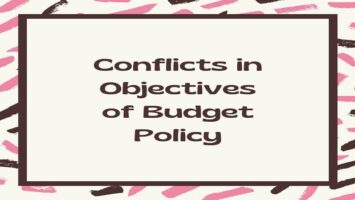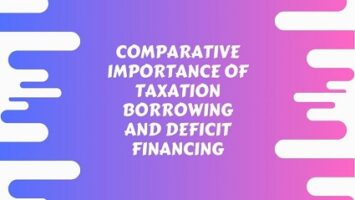Effects of Taxation on Diversion of Resources:
The volume of production and national income of a country depends upon the ability and desire to work and save, but the pattern and composition of production depend upon the allocation of resources as between different industries and localities. Taxation may be used as an instrument of fiscal policy for the diversion of resources between industries and regions. Thus, taxation can affect not only the size and growth of production but also the composition and pattern of production. Hence, the composition and pattern of production may be changed as a result of taxation.
If the products of certain industries are taxed, their prices would rise, and, therefore, the demand for their products would reduce, and thereby the profits are also reduced. This may result in the diversion of resources from these industries to some other industries, whose products are subjected to no tax, or low tax rates. It can be done to minimize the burden of taxation or to avoid the burden of taxation. This diversion of resources may change the composition and pattern of the output of industries.
The extent to which the diversion of resources takes place from taxed industries to non-taxed or low-taxed industries will depend upon the elasticity of demand and supply of the products of such industries. If the demand of the taxed commodity is inelastic and its supply is elastic, the incidence of tax will be relatively more upon the buyer, and hence the diversion of resources would not take place. Contrary to this, if the demand for the product is elastic and its supply is inelastic, the incidence of the tax will fall upon the producer. If the producer finds it unprofitable or comparatively less profitable, to carry on production in taxed industries, the diversion of resources may take place to non-taxed industries.
(1) Beneficial Diversion- Some diversions are, however, beneficial. Taxation on injurious articles of consumption, such as intoxicants, may discourage their production, and the labor and capital engaged in these industries may be shifted to some other use. Taxation on intoxicants and other injurious articles will lead to an increase in their prices, and because of the rise in the prices, the consumption of such articles may be reduced. And the resources, which were used for the consumption of such articles, may be diverted for the consumption of some other useful articles. A check on the consumption of such articles may also improve the health and efficiency of the consumers. Hence, the taxation of such articles is socially desirable. Similarly, a tax on the production of luxuries may divert the labor and capital from it to the production of some other articles of necessities. This type of diversion is also useful, especially in underdeveloped countries.
(2) Harmful Diversion- Taxation on articles of necessity or articles of common consumption may not be socially desirable. Taxation on such articles will increase their prices, and thus, the consumption of such articles may be reduced. This may have an adverse effect upon the health and efficiency of the people. Again the rise in prices will reduce the demand, and hence, reduce the production of such articles. This may reduce profits, and therefore, it is possible that these resources may be diverted from the production of necessaries and the articles of common consumption to some less useful goods. Thus, such a diversion of resources is harmful and socially not desirable.
(3) Diversion of Resources from Present to Future Use- Sometimes, taxes are imposed to discourage consumption and encourage savings. This is generally done in times of planning and development when consumption is reduced, and as a result of taxation, savings are increased. Thus, resources are diverted because of taxation from present uses to future uses. Again, when savings are increased, an investment may also increase, and, thus, the productive power of the community as a whole may be increased. Tax exemptions and concessions to encourage saving have the same effect.
When taxation discourages savings and consumption is increased, this causes a diversion of resources from future use to present use which may have an adverse effect on production. This is more true in cases when revenues collected by way of taxation are spent on day-to-day administration or on unproductive expenditures which otherwise might have been saved and utilized for productive purposes.
(4) Diversion of Resources from one State to Another- In a federal system of political set up when different States follow different types of taxes or adopt different rates of the same taxes, the diversion of resources may take place, from the State where the burden of taxation is heavy to that State, where the burden of taxation is not so heavy. This difficulty may be minimized if uniform rates and patterns are followed all over the country.
(5) Diversion of Resources from One Country to Another- If the burden of taxation in a country is very heavy, the enterprises may feel it profitable to invest their capital in those countries, where the burden of taxation is not so heavy. But, this can be prevented to a certain extent if the entire income of a person is taxed whether earned within a country or received from abroad. This may check the diversion of resources i.e., capital from one country to another, provided the owner of the capital does not shift along with his capital.
(6) Protection and Diversion of Resources- When a government decides to give protection in the form of bounties, grants and exemption from taxation to certain industries, either to face foreign competition or to develop them, there may be the diversion of resources from other industries to these industries, which enjoy the protection of the government. However, this may adversely affect the volume of production in the short period, but in the long run, industrial development would be more rapid, than otherwise would have been possible. Industrial development as a whole would be far more rapid if the unemployed resources are diverted for the establishment of these protected industries.









Comments (No)